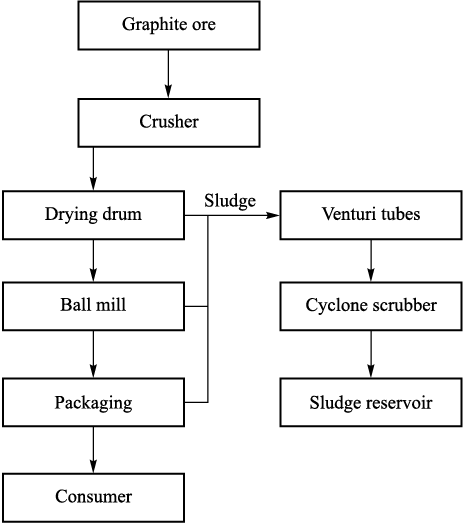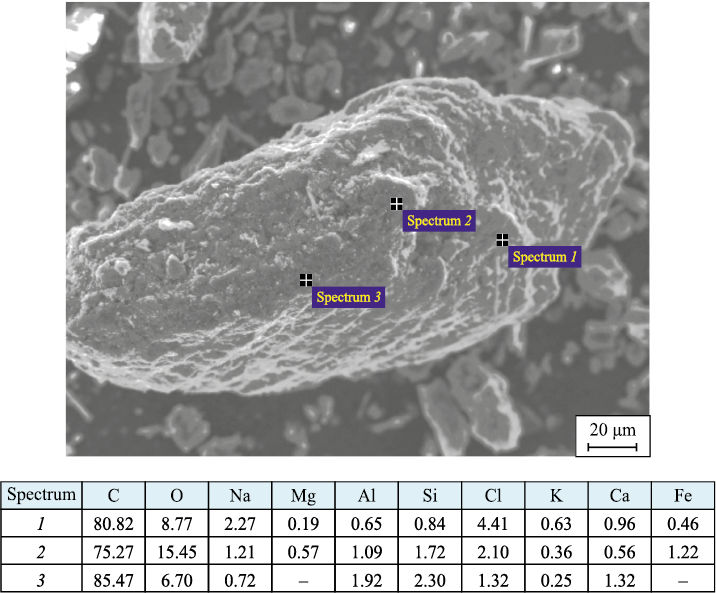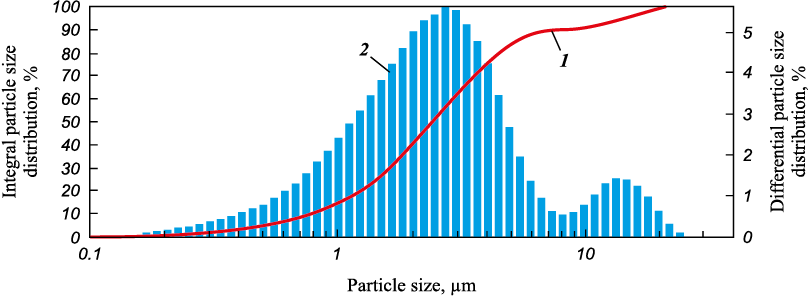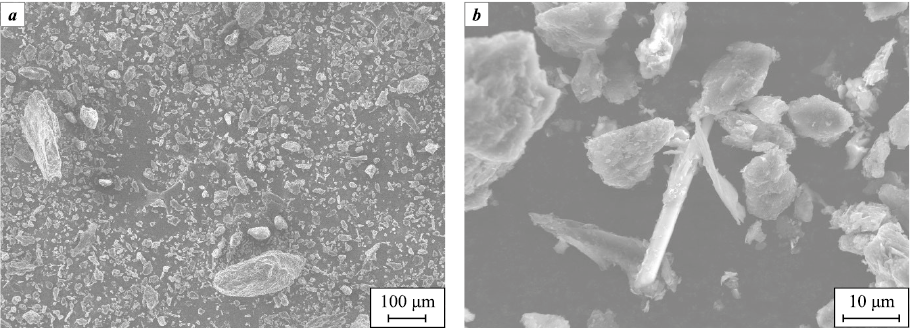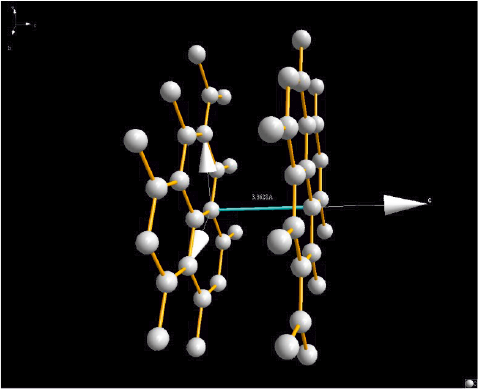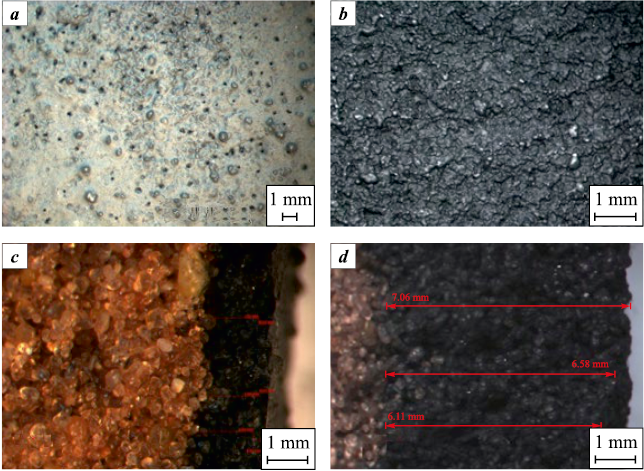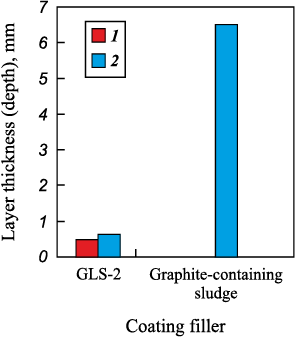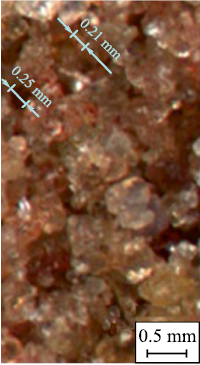Scroll to:
Prospects for the use of graphite-containing sludge for the production of composite coatings
https://doi.org/10.17073/1997-308X-2024-5-66-74
Abstract
Modern technologies must meet the criteria of sustainable development, taking into account economic, environmental, and social indicators. In this study, the potential use of graphite-containing sludge from the gas purification aspiration system during cryptocrystalline graphite production was investigated for its inclusion in composite anti-burn coatings for cast iron casting. The graphite-containing sludge consists of carbon, sulfur, sodium, aluminum, and silicon, with a phase composition that includes graphite, calcite, pyrite, quartz, halite, and others. The sludge is a dispersed material with an average particle size of 3.64 µm, a total surface area of 36,506 cm2/cm3, and a main fraction size of 1–8 µm. Sludge particles exhibit various shapes, ranging from irregular to isometric. Larger isometric particles can reach sizes of 1 mm or more. On the surfaces of larger particles, smaller dispersed particles are present. The structural parameters of the sludge correspond to those of hexagonal graphite. The analysis of the composition and properties of graphite-containing sludge suggests its suitability for use in composite anti-burn coating formulations. However, due to the presence of large graphite aggregates and acicular impurities in the sludge, sieving is required before use. Complete replacement of natural graphite with sludge increases the coating density from 1220 to 1750 kg/m3, viscosity from 34 to 105 s, and abrasion resistance from 175 to 245 g/mm. Due to its high dispersity, the sludge-based coating nearly completely penetrates the pores of the sand-resin mixture mold without forming a cover layer. This does not ensure consistent reduction of burn-on defects on casting surfaces. Therefore, the full substitution of graphite with graphite-containing sludge in composite coating formulations is not recommended.
Keywords
For citations:
Khudonogov S.A. Prospects for the use of graphite-containing sludge for the production of composite coatings. Powder Metallurgy аnd Functional Coatings (Izvestiya Vuzov. Poroshkovaya Metallurgiya i Funktsional'nye Pokrytiya). 2024;18(5):66-74. https://doi.org/10.17073/1997-308X-2024-5-66-74
Introduction
In the last decade, the criteria for product quality have changed, as modern technologies must meet the criteria of sustainable development, which take into account economic, environmental, and social indicators [1–4]. As a result, increasing attention is being paid to the potential for incorporating industrial powder waste into various sectors of industry [5–13].
The experience of using carbon-containing slags from various productions in the compositions of different products has been described in works [14–16]. The advantages of using carbon-containing waste not only enhance the quality of products based on them but also reduce the volume of sludge fields surrounding enterprises, thus contributing to environmental preservation. For example, the processing of graphite-containing dust from metallurgical production allows for the production of high-quality raw materials for a wide range of applications, while also generating additional profit by lowering production costs. On the other hand, the variable composition of the waste, which determines the nature of its thermal degradation, along with insufficient development of technologies, results in the majority of the waste currently being sent to landfills.
In the Krasnoyarsk region, there is a graphite processing enterprise working with the Kureiskoye deposit, which primarily produces cryptocrystalline graphite of the GLS grade, carburizer of the NSGK grade, and sorbent of the SGN-30 grade [17]. After graphite processing, sludge remains, which is stored at the enterprise and subsequently either disposed of or partially recycled.
The purpose of this study was to investigate the composition and properties of graphite-containing sludge and to develop graphite-based coatings for casting molds.
Research methodology
The graphite-containing sludge used in this research was sourced from the gas purification aspiration system during the production of cryptocrystalline graphite (Fig. 1).
Fig. 1. Schematic of cryptocrystalline graphite production |
The elemental and phase compositions of the sludge were assessed using an XRD-7000 X-ray diffractometer (Shimadzu, Japan) [18]. The elemental composition of the sludge particles was also determined through energy-dispersive microanalysis, using an energy-dispersive spectrometer from Oxford Insruments (UK), mounted on the column of a JSM-7001F scanning electron microscope (JEOL, Japan) [19]. The spectra of characteristic X-ray emissions from the chemical elements present in the powders were determined at specific points.
The size and total surface area of the sludge particles, as well as their size distribution, were analyzed using the light-scattering method with the Fritsch Analysette 22 MicroTec PLUS laser particle size analyzer (Germany).
The graphite-containing sludge was tested as part of a self-drying composite coating [20; 21].
The properties of the coatings were determined according to GOST 17022–78. The thickness of the cover layer and the depth of the penetrating layers were measured using an Observer.D1m microscope (Carl Zeiss, Germany), and the burn-on level was evaluated using the step test described in [22].
Results and discussion
The elemental composition of the sludge (wt. %) assessed using the XRD-7000 X-ray diffractometer is presented below:
| O . . . . . . . . 26.00 |
| C . . . . . . . . 45.85 |
| H . . . . . . . . 0.24 |
| Na . . . . . . . . 0.61 |
| Cl . . . . . . . . 0.94 |
| S . . . . . . . . . 1.95 |
| Si . . . . . . . . 13.10 |
| Mg . . . . . . . . 4.51 |
| Ca . . . . . . . . . 5.10 |
| Fe . . . . . . . . . 1.70 |
The elemental composition of the sludge particles was also determined using the JSM-7001F scanning electron microscope, and the results are shown in Fig. 2.
Fig. 2. Elemental composition (wt. %) of sludge particles |
The obtained data indicate that the sludge is mainly composed of carbon, sulfur, sodium, aluminum, and silicon.
The phase composition of the sludge (Table 1) includes graphite (up to 47 %), calcite (up to 13 %), pyrite (up to 4 %), quartz (up to 21 %), halite (up to 2 %), with other impurities making up to 17 %.
Table 1. Phase composition of GLS-2 graphite and graphite-containing sludge
| ||||||||||||||||||||||||||
The reduced pyrite content compared to natural graphite will help decrease burn-on defects on casting surfaces, as discussed in detail in [23]. Calcite, halite, and quartz are materials whose presence increases the coating’s refractoriness (due to their high melting points) and prevents interaction between the melt and the molding mixture. Clay minerals (kaolinite, montmorillonite, etc.), present among other phases in the sludge, will act as binders, providing the coatings with higher strength.
The sludge is a dispersed material with an average particle size of 3.64 µm and a total surface area of 36,506 cm2/cm3. The study of particle size distribution showed that the majority of particles fall within the range of 1–8 µm (Fig. 3).
Fig. 3. Fractional composition of the sludge |
Morphological analysis of the particles (Fig. 4) revealed that the sludge contains particles of various sizes and shapes, ranging from irregular to isometric.
Fig. 4. Sludge images from the JSM-7001F microscope |
The majority of the material is uniform, but there are large graphite aggregates and cylindrical inclusions. Smaller dispersed particles are observed on the surface of larger particles. Large inclusions can reach sizes of ≥1 mm. The cylindrical inclusions are impurity phases.
The analysis of the sludge structure showed that its parameters correspond to the hexagonal form of graphite. This suggests that the sludge can be recommended for use in composite coatings, provided the large graphite aggregates and cylindrical impurities are removed by sieving. Fig. 5 presents a 3D model of the graphite structure, simulated in the TOPAS 3 program.
Fig. 5. Simulated graphite structure in the TOPAS 3 program |
The study examined the feasibility of using graphite-containing sludge in the composition of anti-burn coatings for cast iron casting.
To study the thickness of the covering and depth of the penetrating layers of the coating, a cold-setting mixture with the following composition (wt. %) was used: 97.2 – quartz sand 2К1О303; 2.4 – alphabond resin; 0.4 – T-01 hardener. The working life of this mixture is 3.2 min, and the tensile strength (after 1 h) is 0.19 MPa.
The properties of composite anti-burn coatings based on graphite-containing sludge are shown in Fig. 6.
Fig. 6. Properties of anti-burn coatings based on GLS-2 graphite (1) and graphite-containing sludge (2) |
The composite coating based on graphite-containing sludge has a higher density and requires additional dilution with PVB lacquer, which may reduce the sludge content.
The thickness of the covering and the depth of the penetrating layers of the coating are shown in Figs. 7 and 8. The composite coating based on graphite-containing sludge does not form a covering layer, while the depth of the penetrating layer can reach 6.0–6.5 mm. This is because the sludge particles (~3.6 µm) are significantly smaller than the pores of the mold (~230 µm, Fig. 9).
Fig. 7. Covering (а, b) and penetrating (c, d) layers of the coating
Fig. 8. Thickness of the covering (1) and depth
Fig. 9. Pores of the mold |
In the study of burn-on magnitude on casting surfaces, a step sample was used. A cold-setting mixture was selected for the research.
During the tests at a temperature of 1400 °C, gray cast iron of the SCH20 grade was poured, with the following composition (wt. %:
| С . . . . . . . . . 2.90–2.97 |
| Mn . . . . . . . . 0.92–0.93 |
| P . . . . . . . . 0.019–0.021 |
| S . . . . . . . . 0.042–0.044 |
| Cr . . . . . . . . . 0.10–0.11 |
| Si . . . . . . . . . 2.41–2.60 |
| Ni . . . . . . . . 0.084–0.086 |
| Cu . . . . . . . . . 0.12–0.13 |
| V . . . . . . . . . 0.049–0.052 |
| Ti . . . . . . . . 0.021–0.024 |
| Sn . . . . . . . . . . . . . <0.01 |
The effect of casting wall thickness on burn-on magnitude is shown in Tables 2 and 3.
Table 2. Burn-on thickness on the surface of castings
Table 3. Burn-on thickness on the surface of castings
| ||||||||||||||||||||||||||||||||||||||||||||||||||||||||||||||||||||||||||||||||||||||
When graphite is replaced with graphite-containing sludge in the coating, the average burn-on thickness on the casting surfaces decreases. This is due to changes in the phase composition and the smaller particle size of the sludge, which oxidizes more quickly during the heating of the mold surface layers, creating a reducing atmosphere.
However, the variation in burn-on values is significantly higher in the case of graphite-containing sludge. This is due to the higher sulfur content in the form of pyrite, which contributes to an increase in burn-on thickness.
Thus, the results indicate that it is not possible to completely replace natural graphite in the composite coating with graphite-containing sludge. Therefore, further research is required to explore the partial replacement of natural graphite with graphite-containing sludge.
Conclusion
This study has demonstrated the potential for using graphite-containing sludge from the gas purification aspiration system in cryptocrystalline graphite production as part of composite anti-burn coatings. The results of the sludge’s elemental composition analysis show that it consists of carbon, sulfur, sodium, aluminum, and silicon. The phase composition of the sludge includes graphite (up to 47 %), calcite (up to 13 %), pyrite (up to 4 %), quartz (up to 21 %), halite (up to 2 %), and other impurities (up to 17 %). The sludge is a dispersed material with an average particle size of 3.64 µm (total surface area – 36,506 cm2/cm3); most particles range from 1 to 8 µm. The sludge contains particles of various shapes: the bulk of them measure between 1 and 8 µm, with shapes ranging from irregular to isometric. Larger isometric particles can reach sizes of 1 mm or more. Smaller dispersed particles are present on the surfaces of larger particles. Acicular impurity phases are also present in the sludge. Analysis of the sludge’s parameters indicates that it can be used in composite coatings, provided that large graphite aggregates and cylindrical impurities are removed by sieving. In composite anti-burn coatings where natural graphite is replaced with sludge, it is possible to increase the density from 1220 to 1750 kg/m3, viscosity from 34 to 105 s, and relative strength from 175 to 245 g/mm. However, due to the high dispersity of the sludge, the coating completely penetrates the pores of the sand-resin mold mixture without forming a surface layer. With complete replacement of graphite with graphite-containing sludge in the coating, the average burn-on thickness on the surface of the castings decreases, depending on the wall thickness, from 53.54–151.30 to 15.98–95.36 µm (on the side surface of the castings) and from 105.80–179.70 to 66.80–128.94 µm (on the bottom surface of the castings). However, the variation in burn-on thickness is significantly higher, which is attributed to the higher sulfur content in the graphite-containing sludge, contributing to increased burn-on thickness. Therefore, further research should focus on the partial replacement of graphite with graphite-containing sludge, which would reduce the cost of the coatings and improve the quality of cast iron products.
References
1. Yakovleva E.A. Opportunities and barriers of a cyclical economy in government regulation. In: Mechanisms of development of socio-economic systems of the region: Collection of articles of the 12th International Scientific and Practical Conference (18 April 2019). Voronezh: Volmi, 2019. P. 57–61. (In Russ.).
2. Romanova O.A., Sirotin D.V. Environmental and economic efficiency of recycling industrial waste in the Urals. Economy of Regions. 2021;17(1):59–71. (In Russ.). https://doi.org/10.17059/ekon.reg.2021-1-5
3. Gilmanshina T.R., Kovaleva A.A., Khudonogov S.A., Kritsky D.Yu. Use of graphite-containing sludge in the composition of non-stick coatings. Chernye Metally. 2022;(4):23–26. (In Russ.). https://doi.org/10.17580/chm.2022.04.04
4. Federal law of 21 July 2014, No. 219-FZ “On amendments to the Federal law “On environmental protection” and certain legislative acts of the Russian Federation” (as amended and supplemented on 26 July 2019). (In Russ.).
5. Vlasova V.V., Fomina E.Yu. The technology of the processing CHP-plant ash and slag wastes with obtaining ferrous raw materials for iron and steel industry. Chernye Metally. 2019;(7):67–72. (In Russ.).
6. Lee W.-H., Wu Y.-F., Ding Y.-C., Cheng T.-W. Fabrication of ceramic moulds using recycled shell powder and sand with geopolymer technology in investment casting. Applied Sciences. 2020;10(13):4577. https://doi.org/10.3390/app10134577
7. Moiz Khan M., Jadhav G.N., Mahajani S.M., Singh M. Comparative study of waste foundry sand reclamation techniques. In: Proceedings of 73rd World Foundry Congress WFC 2018 (Poland, Krakow, 23–27 September 2018). Poland, Krakow, 2018. P. 119–120.
8. Drozyński D., Bobrowski A., Holtzer M. Influence of the reclaim addition on properties of moulding sands with the geopol binder. Archives of Foundry Engineering. 2015;15(1):138–142. https://doi.org/10.1515/afe-2015-0025
9. Kvashevaya E., Ushakova E., Ushakov A. Carbon-containing waste of coal enterprises in magnetic sorbents technoligy. E3S Web of Conferences. 2017;21:01003. https://doi.org/10.1051/e3sconf/20172101003
10. Kuz’min M.P., Larionov L.M., Kondratiev V.V., Kuz’mina M.Yu., Grigoriev V.G., Kuz’mina A.S. Use of the burnt rock of coal deposits slag heaps in the concrete products manufacturing. Construction and Building Materials. 2018;179:117–124. https://doi.org/10.1016/j.conbuildmat.2018.05.222
11. Taha Y., Benzaazoua M., Hakkou R., Mansori M. Coal mine wastes recycling for coal recovery and eco-friendly bricks production. Minerals Engineering. 2017;107:123–138. https://doi.org/10.1016/j.mineng.2016.09.001
12. Agrawal A., Sahu K.K., Pandey B.D. Solid waste management in non-ferrous industries in India. Resources, Conservation and Recycling. 2004;42(2):99–120. https://doi.org/10.1016/j.resconrec.2003.10.004
13. Yildiz T.D., Tombal T.D. Challenges and recovery opportunities in waste management during the mining and enrichment processes of ores containing uranium and thorium – A review. Gospodarka Surowcami Mineralnymi – Mineral Resources Management. 2024;40(1):25–62. https://doi.org/10.24425/gsm.2024.149305
14. Bagryantsev V.I., Kazimirov S.A., Kutsenko A.I., Podolskiy A.P., Rybushkin A.A., Temlyancev M.V. The practice and prospects of using solid carbon-containing waste as fuel for thermal power units. Bulletin of the Siberian State Industrial University. 2013;3(5):33–37. (In Russ.).
15. Fadeeva N.V., Orekhova N.N., Gorlova O.E. Experience of graphite-containing dust of metallurgycal plants processing. Ferrous Metallurgy. Bulletin of Scientific. 2019;75(5):632–640. (In Russ.). https://doi.org/10.32339/0135-5910-2019-5-632-639
16. Mulyavko V.I., Oleinik T.A., Lyashenko V.I., Oleinik M.O. The improvement in the efficiency of the utilization of the graphite containing dust formed in the metallurgical production. Ferrous Metallurgy. Bulletin of Scientific. 2015;(11):67–76. (In Russ.).
17. Company “KrasnoyarskGrafit”. URL: https://www.graphite-ore.com/en/ (accessed: 08.04.2024).
18. Shimadzu. Excellence in Science. URL: https://www.shimadzu.ru (accessed: 08.04.2024).
19. Product Jeol. URL: https://jeol.com (accessed: 08.04.2024).
20. Amelchenko V.N., Illarionov I.E., Gilmanshina T.R., Borisyuk V.A. Graphite as a prospective material for metallurgical application. CIS Iron and Steel Review. 2018;16:29–32. https://doi.org/10.17580/cisisr.2018.02.06
21. Illarionov I.E., Gilmanshina T.R., Kovaleva A.A., Bratukhina N.A. Understanding the effect of structural defects in graphite on the properties of foundry coatings. CIS Iron and Steel Review. 2018;16:63–66. https://doi.org/10.17580/cisisr.2018.02.13
22. Illarionov I.E., Kaftannikov A.S., Nuraliev F.A., Gilmanshina T.R. Evaluation of burn value on surface of iron castings. Chernye Metally. 2018;(8):23–28.
23. Gilmanshina T.R., Dubova I.V., Vasyunina N.V., Kovaleva A.A. Analysis of physical-chemical processes occurring on the boundary between the melt and non-stick coating. CIS Iron and Steel Review. 2021;21:38–42. https://doi.org/10.17580/cisisr.2021.01.06
About the Author
S. A. KhudonogovRussian Federation
Sergei A. Khudonogov – Senior Lecturer, Departament of applied mechanics, Polytechnic Institute
79 Svobodny Prosp., Krasnoyarsk 660041, Russia
Review
For citations:
Khudonogov S.A. Prospects for the use of graphite-containing sludge for the production of composite coatings. Powder Metallurgy аnd Functional Coatings (Izvestiya Vuzov. Poroshkovaya Metallurgiya i Funktsional'nye Pokrytiya). 2024;18(5):66-74. https://doi.org/10.17073/1997-308X-2024-5-66-74




